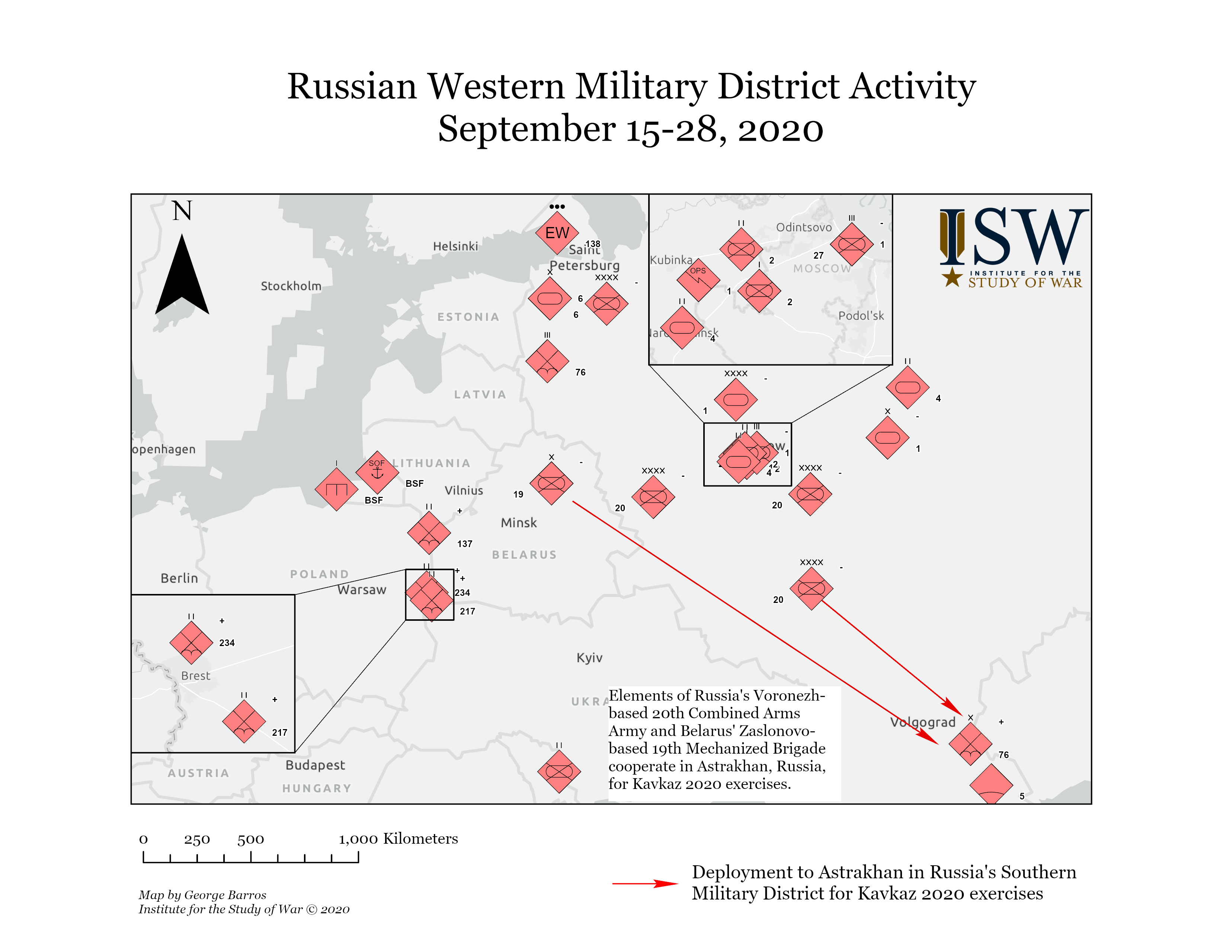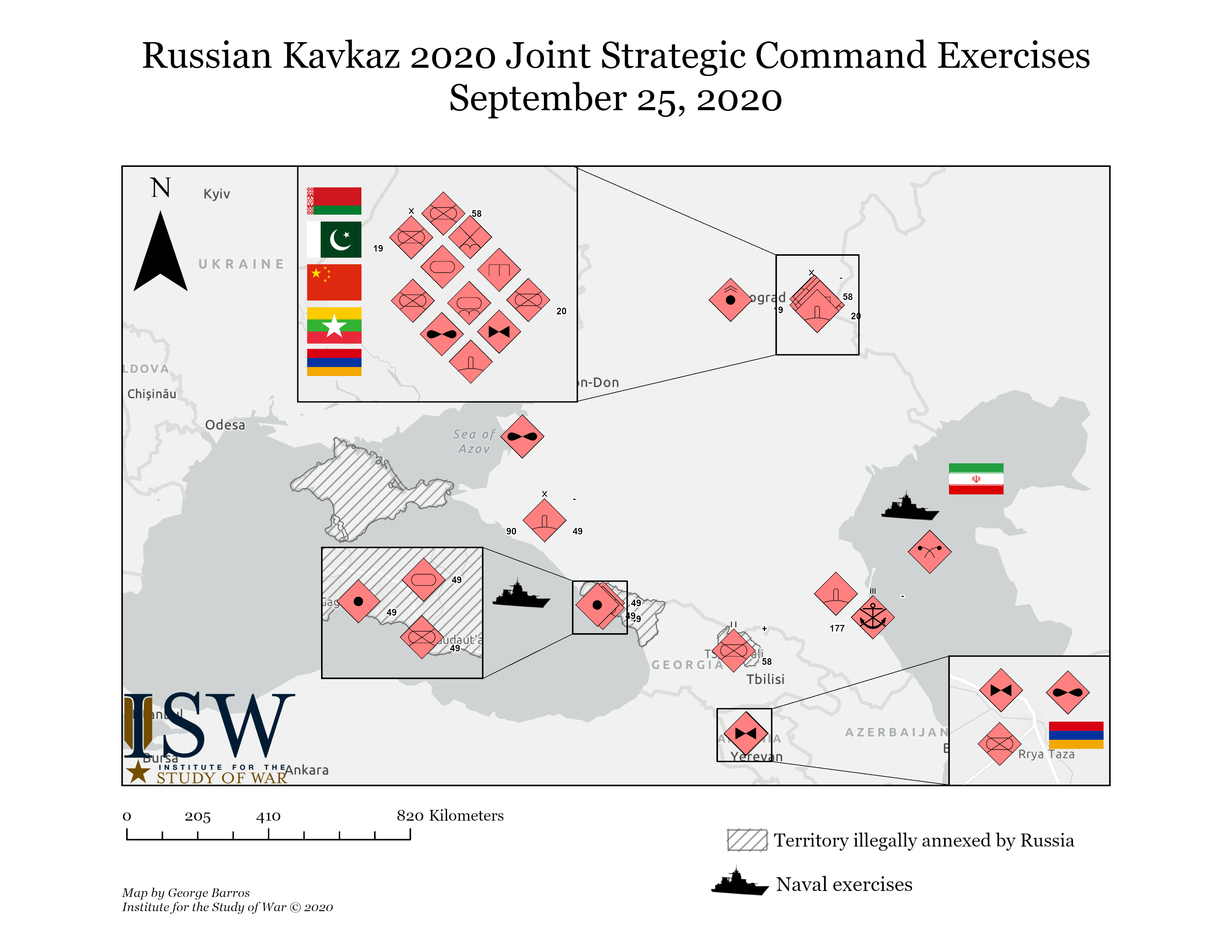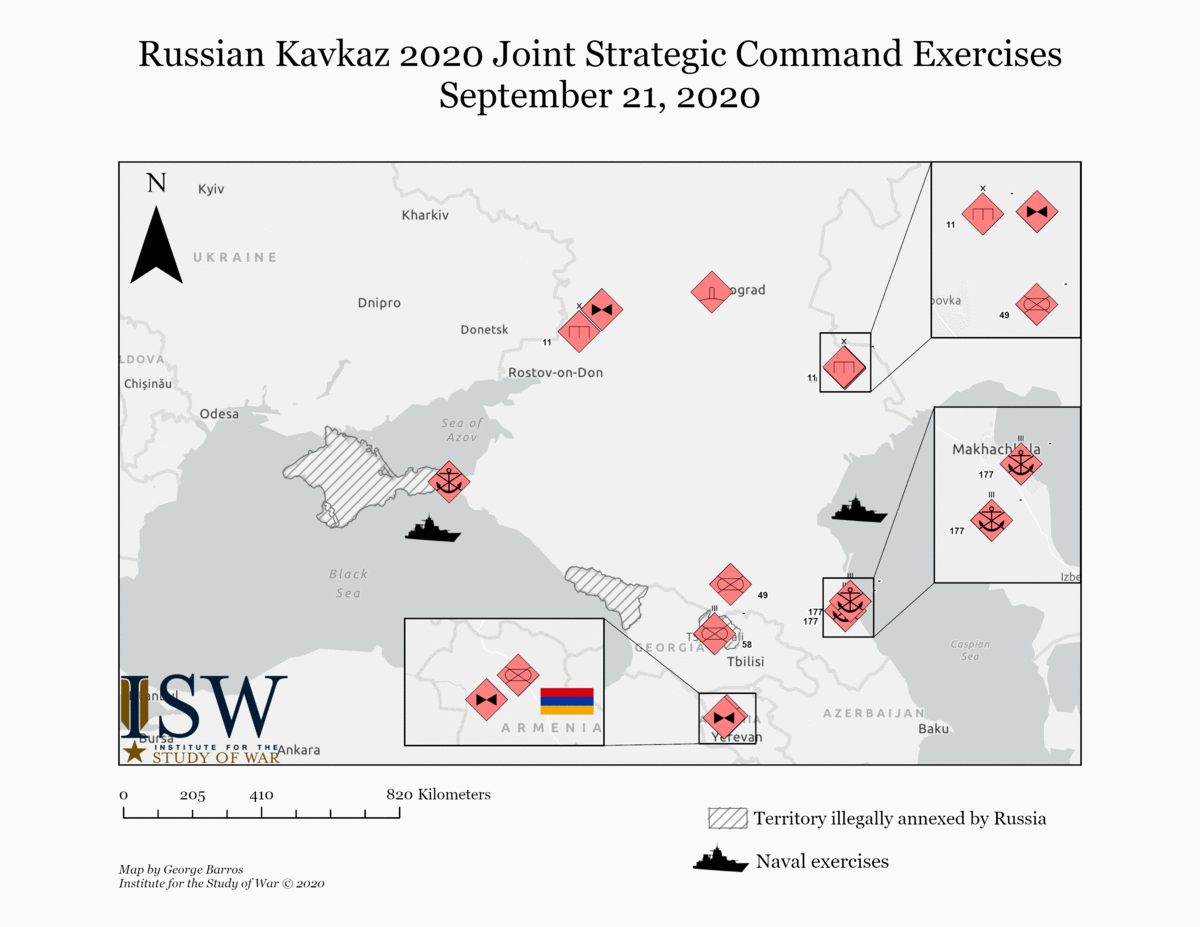 |
 |
Russia’s Unprecedentedly Expansive Military Exercises in Fall 2020 Seek to Recreate Soviet-Style Multinational Army

October 20, 2020
By Mason Clark and George Barros
Key Takeaway: The Kremlin has conducted military exercises in fall 2020 on an unprecedented scale, much deeper than usual integration of Russian and foreign military units, and a pattern of modifying pre-announced activities significantly but presenting them as normal and unchanged. These exercises mark significant developments in the Kremlin’s campaigns to integrate the security forces of Former Soviet Union (FSU) states into Russian-dominated structures. Russian forces conducted simultaneous exercises on a scale nearly equivalent to that of two normal annual capstone exercises, suggesting that Russian forces may be able to mobilize and control more combat units and at higher echelons than had previously been assessed. The Kremlin covered new deployments to Belarus by branding them as “preplanned exercises” to create a false sense of normality. The Kremlin will likely exploit this kind of rebranding as an instrument of its hybrid warfare toolkit to cover actual combat deployments abroad. Moscow also announced that it would intensify efforts to gain United Nations recognition of the revivified multinational military it is trying to create in the FSU as a legitimate peacekeeping force. There are several concrete steps the United States and NATO should take to mitigate these new threats.
The Kremlin conducted military exercises in Fall 2020 on an unprecedented scale to advance efforts to recreate a multinational armed forces of the former Soviet states for which it seeks UN approval as a legitimate peacekeeping force. It concealed the significance of these exercises by casting them as pre-announced and pre-planned despite making major changes immediately before their execution.
Russian forces in the Western and Southern Military Districts conducted unprecedented simultaneous exercises near the scale of two normal annual capstone readiness exercises in September. Russian Western Military District (WMD) forces exercised in both Belarus and the WMD on September 15-28 on a larger scale than they did during the last annual capstone exercise in the WMD in 2017.[1] Kavkaz-2020, this year’s iteration of Russia’s annual capstone military readiness exercises in the Southern Military District on September 21-26, should have precipitated a decrease in WMD activity but did not.[2]
Click here to expand the map below.

These unprecedented exercises seek to subordinate FSU militaries to the Kremlin to recreate a multinational army in the former Soviet space. The Kremlin created a combined Russian-Belarusian combat battalion for the first time during the Slavic Brotherhood exercises from September 14-25.[3] The Kremlin has previously used joint exercises with Belarus—most notably Union Shield 2019—to integrate Belarusian forces into Kremlin-run structures, but has not created joint combat units dynamically during an exercise prior to September 2020.[4] A successful Kremlin effort to institutionalize joint units in Belarus or elsewhere would magnify the Kremlin’s power projection capabilities and enable the Kremlin to exert direct control over elements of FSU militaries in the event of Russian deployments. Success in this effort might give Moscow the ability to subvert parts of the units of those militaries even against the orders of their governments, although it is impossible to assess that risk with any confidence. The Kremlin used Kavkaz-2020 to increase interoperability between Russian, Belarusian, Armenian, Kremlin proxy republic, Chinese, Iranian, Pakistani, and Myanma units.[5] The Kremlin deployed personnel from both the CSTO’s secretariat and joint staff for the first time during Unbreakable Brotherhood 2020, and prioritized increasing interoperability between CSTO commanders, planning staffs, and combat subunits.[6] One of Russian President Vladimir Putin’s core grand strategic objectives is to regain dominant influence over FSU states by controlling FSU security structures through joint exercises, security cooperation agreements, and Russian basing rights.[7]
Click here to expand the map below.

Click here to expand the animated map below.

The Kremlin will attempt to legitimize its multinational armed forces in the CSTO as a United Nations (UN)-approved peacekeeping force. After Unbreakable Brotherhood’s completion, the CSTO stated it plans to conduct negotiations with the UN in 2021 to hold CSTO peacekeeping operations under the auspices of the UN, in line with the Kremlin’s campaign to leverage the UN to justify its own international military deployments.[8] The Kremlin will leverage the veneer of international coalitions to legitimize its hybrid operations.[9]
The Kremlin concealed the nature and implications of these exercises by branding them as “preplanned exercises” to create a false sense of normality—an important hybrid war capability. Russian information operations downplayed the significance of the fact that Russian forces effectively conducted exercises approximating two annual capstone exercises simultaneously by refraining from establishing any overarching rubric for the collective activities in the WMD. The Kremlin misrepresented its adaptations to Slavic Brotherhood and Unbreakable Brotherhood exercises to avoid alarming NATO by claiming the exercises as a whole were pre-planned without acknowledging the significant changes made to the composition and activities of both exercises shortly before they began.[10] Russian information operations further emphasized Russian de-escalation in Belarus by staging an ostentatious but mostly symbolic withdrawal of a Russian law enforcement reserve force from the Russian-Belarusian border a day after Slavic Brotherhood began.[11]
The Kremlin will likely exploit Western inattention to further alter preannounced military exercises on short notice. The Kremlin could use this approach to cover actual combat deployments abroad if the West is unable to properly account for changes. The Kremlin’s increasing prioritization of simultaneous multinational exercises poses an additional threat of enabling Russian troops to establish an increased force presence throughout the FSU through near-continuous deployments for exercises. It may be difficult to distinguish between these frequent exercise deployments and the permanent stationing of Russian troops in new bases in former Soviet states.
Russian forces may be able to mobilize faster and in greater numbers than has been previously assessed. The Kremlin demonstrated remarkable flexibility to adapt pre-announced military exercises to meet evolving situations with its exercises in September and October. The Kremlin had announced and partially planned Slavic Brotherhood, Kavkaz-2020, and Unbreakable Brotherhood prior to September 2020. The Kremlin adapted the exercises on short notice both to react to factors outside its control—such as Azerbaijan’s and Kyrgyzstan’s withdrawal from the exercises due to crises—and to exploit the Kremlin’s increasing presence in Belarus during ongoing protests. Putin adapted to Serbia’s withdrawal from Slavic Brotherhood and the justification for increased Russian military deployments to Belarus provided by ongoing to protests to increase Slavic Brotherhood’s length and likely scope on short notice.[12] The Kremlin leveraged Kavkaz-2020 to practice joint combat operations between elements of Russia’s WMD and Belarusian units, possibly to prepare WMD units to deploy to Belarus.[13] The Kremlin likely adapted to Armenian, Kyrgyz, and Kazakh withdrawals from Unbreakable Brotherhood exercises by modifying the exercises’ format and increasing their planned size.[14]
The Kremlin demonstrated improved hybrid war capabilities in these exercises by increasing its ability to obfuscate its deployments and leverage partner militaries. The Kremlin is using military exercises to leverage other states’ resources to achieve Russian objectives. Putin included CSTO participants and International Committee of the Red Cross observers in Unbreakable Brotherhood to frame Russian deployments to Belarus as legitimate and internationally accepted, despite Russia’s intensified efforts to undermine Belarus’s sovereignty.[15] The Kremlin is exploiting innovations in information operations and exercises to gain a continuous or near-continuous Russian force deployment to Belarus under the rubric of recurring monthly exercises.[16] Russia’s push to mask deployments to Belarus as international joint efforts is consistent with the way Russian military thinkers conceive of informational cover for hybrid war.[17] These exercises greatly advance the Kremlin’s campaign in the former Soviet Union and demonstrate the Russian armed forces possess greater operational flexibility than previously assessed.
The United States and NATO should take several steps to mitigate these threats. The West should closely monitor Russian military exercises and challenge Russian assertions that its exercises are “business as usual” when they, in fact, are extraordinary. The West should call out Russian efforts to undermine FSU states’ sovereignty by subordinating FSU militaries to Russian-dominated structures. The United States should increase outreach to NATO Partnership for Peace program members and communicate the unacceptability of their participation in Russian hybrid operations that Moscow bills as multilateral peacekeeping exercises, sometimes with explicitly anti-NATO objectives. The West should also call out Russian efforts to manipulate the information space by characterizing its hybrid operations as multilateral exercises. It should pressure the UN not to recognize the CSTO as a legitimate peacekeeping force.
[1] https://www.iswresearch.org/2020/09/warning-putin-is-setting-conditions-for.html; https://www.iswresearch.org/2020/09/the-kremlin-deploys-brigade-sized-force.html; http://www.iswresearch.org/2020/09/belarus-warning-update-russia-and.html; http://www.iswresearch.org/2020/09/belarus-warning-update-kremlin-may-have.html; http://www.iswresearch.org/2020/09/belarus-warning-update-kremlin-is.html; http://www.iswresearch.org/2020/10/belarus-warning-update-russias-western.html
[2] https://www.iswresearch.org/2020/09/the-kremlin-deploys-brigade-sized-force.html; https://www.mil dot by/ru/news/106283/; http://www.iswresearch.org/2020/09/warning-putin-is-setting-conditions-for.html
[3] http://www.iswresearch.org/2020/09/belarus-warning-update-multiple-russian.html; https://www.iswresearch.org/2020/10/belarus-warning-update-russias-western.html
[4] https://www.iswresearch.org/2019/09/russia-in-review-military-exercises-as.html
[5] https://www.iswresearch.org/2020/09/warning-russias-kavkaz-2020-military.html
[6] https://www.interfax dot ru/world/731647; https://odkb-csto dot org/news/news_odkb/komandno-shtabnoe-uchenie-s-mirotvorcheskimi-silami-odkb-nerushimoe-bratstvo-2020-proydet-v-respubli/; http://www.understandingwar.org/sites/default/files/Russian%20Hybrid%20Warfare%20ISW%20Report%202020.pdf; http://www.understandingwar.org/sites/default/files/Putin%27s%20Offset%20The%20Kremlin%27s%20Geopolitical%20Adaptations%20Since%202014.pdf
[7] http://www.understandingwar.org/sites/default/files/Putin%27s%20Offset%20The%20Kremlin%27s%20Geopolitical%20Adaptations%20Since%202014.pdf
[8] https://sputnik dot by/defense_safety/20201016/1045917923/ODKB-provedet-peregovory-s-OON-ob-uchastii-v-mirotvorcheskikh-operatsiyakh.html; https://www.youtube.com/watch?v=yiuyVyRIEVg
[9] http://www.understandingwar.org/sites/default/files/Putin%27s%20Offset%20The%20Kremlin%27s%20Geopolitical%20Adaptations%20Since%202014.pdf
[10] https://www.iswresearch.org/2020/09/belarus-warning-update-multiple-russian.html; https://www.iswresearch.org/2020/09/warning-putin-is-setting-conditions-for.html; https://russian.rt dot com/ussr/news/793008-odkb-nerushimoe-bratstvo; https://iz dot ru/1074144/2020-10-15/gensek-odkb-obiasnil-smysl-provedeniia-uchenii-nerushimoe-bratstvo-2020; https://www.interfax dot ru/world/731647
[11] http://www.iswresearch.org/2020/09/belarus-warning-update-putin-sends.html
[12] http://www.iswresearch.org/2020/09/belarus-warning-update-putin-sends.html; https://www.iswresearch.org/2020/09/the-kremlin-deploys-brigade-sized-force.html; https://www.iswresearch.org/2020/09/belarus-warning-update-russian-force.html; https://www.iswresearch.org/2020/09/warning-putin-is-setting-conditions-for.html
[13] http://www.iswresearch.org/2020/09/warning-russias-kavkaz-2020-military.html; https://www.iswresearch.org/2020/09/belarus-warning-update-kremlin-may-have.html
[14] The number of personnel participating in Unbreakable Brotherhood increased by approximately 30 percent from the initially declared figure despite the pullout of half of the exercises’ participants. http://www.iswresearch.org/2020/10/belarus-warning-update-police-detain.html; https://function.mil dot ru/news_page/country/more.htm?id=12319434@egNews
[15] http://www.iswresearch.org/2020/10/belarus-warning-update-kremlin-will.html
[16] http://www.iswresearch.org/2020/09/belarus-warning-update-kremlin-is.html
[17] http://www.understandingwar.org/sites/default/files/Russian%20Hybrid%20Warfare%20ISW%20Report%202020.pdf